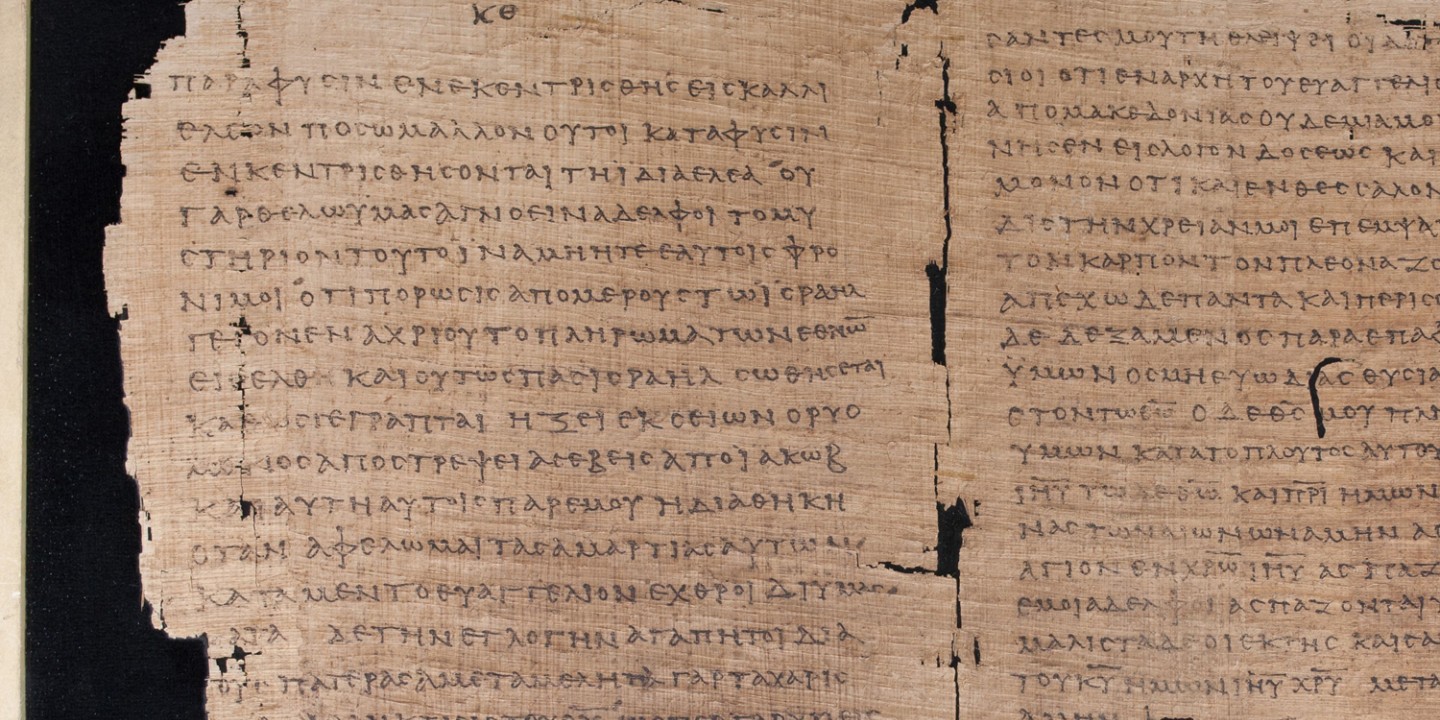Paul’s lost letters
We’ll never know what he wrote to the churches at Jerusalem or Caesarea Maritima.

Bifolio from Paul’s letter to the Romans, the end of Paul’s letter to the Philippians, and the beginning of Paul’s letter to the Colossians. (University of Michigan / Chester Beatty Library / Creative Commons)
Have you ever read St. Paul’s powerful letters to the church at Jerusalem? How about to the Damascenes? To the people of Caesarea Maritima?
Obviously, you have not. But the fact that we do not possess such things demands some explanation. It tells us a great deal about how our scriptures reached the shape they did—and about what Paul regarded as his central message.
Paul traveled widely in the Eastern Mediterranean world, roughly between the mid-’30s and early ’60s. He visited many cities and communities and assuredly wrote letters to many of them. Yet we have his correspondence with only a select few. Why?
Let’s begin with things we can say with high confidence. Probably in the ’90s, Luke was composing his book of Acts, and he certainly did not know Paul’s letters—nothing whatever. If he had, he would have cited Paul’s ideas and speech differently. He would have changed his narrative in various ways, for instance, in the details of what Paul does after his conversion. He would also have added references to people mentioned in the letters and developed them as characters. So here is an author very interested in Paul, well informed and curious about sources, yet who does not know what we regard as the most basic building blocks of the story.
Read our latest issue or browse back issues.
Now fast-forward a generation or so, when Paul was viewed as a great Christian hero, his letters widely known and quoted by the Apostolic Fathers. By around the first quarter of the second century, Paul’s letters were well enough known to inspire imitators and mimics in the form of the pastoral epistles. Before the ’90s or so, Paul’s letters were not known as a collection—indeed, did not exist as a collection—and then within 25 years they became available and quite popular.
So what happened in the intervening years? What did not happen is that somebody turned up a letter book from one of Paul’s secretaries or scribes, a record of letters as they had been dictated, copied, and sent. The various letters exist in a wide range of states and conditions, and some (like the Corinthian correspondence) have been sliced, diced, and recombined from their original state. The letters as we have them represent the form not in which they were sent but in which they were received and preserved, in multiple locations spread over a sizable geographical area.
One explanation, and I am far from the first to suggest this, is that somebody wanted to commemorate or glorify Paul and made a deliberate effort to seek out any writings of his they could obtain. Perhaps they contacted various churches to see if they might have anything in their records. Perhaps one individual, or a few friends, actually traveled to various churches to see what they could turn up in their respective attics. In some cases, the searchers presumably drew a blank. They found what they could, and we have no idea what their actual success rate might have been.
As to the principle of selection, the one thing all the surviving letters have in common is how thoroughly they follow the geography outlined in Acts. If you just used Acts as a source of places to check, you would immediately hit names like Corinth, Philippi, Ephesus, Thessaloniki, and Rome. If Acts does not mention Colossae, it certainly mentions Phrygia as a region. If you were trying to contact someone in that area, a natural place to write to would have been Colossae, a key Phrygian city. The general letter to the Galatians was addressed to one or more of the cities of that province named in Acts, such as Iconium, Derbe, and Lystra.
The obvious person to undertake such a research project would have been a rich and well-connected Christian sympathizer, someone with a staff of scribes and servants—someone like the “most excellent” Theophilus to whom Luke dedicates his Gospel and Acts. I offer a speculation. Did Theophilus read Acts, get inspired, and seek to know more about the book’s hero? Did he commission his staff to work through the book, listing place names and contacting churches or Christian leaders there? In the language of whodunits, Theophilus had the means, the motive, and the opportunity to track down and collect Paul’s letters. And just a decade or two after the hypothetical events I am describing, those same letters started their literary career and duly became part of scripture.
But the searchers faced a problem: they could only find those letters that survived. The crucial fact here is the great Jewish revolt and ensuing war that raged between 66 and 73, during which Jewish communities were uprooted and slaughtered across the region—and so were members of the Jewish sect that followed Jesus of Nazareth. That was what happened in such crucial early centers of the Jesus movement as Caesarea Maritima, Alexandria, Damascus, Tyre, Joppa, and of course, Jerusalem. If Paul had written to communities in those cities, all the correspondence was destroyed. With one conspicuous exception—the city of Antioch—all the places that Acts identifies as the scene of key events in ancient Israel and Syria had their Jewish and Jewish-Christian populations uprooted or annihilated between 66 and 73. Paul’s letters only survived in gentile-dominated regions where there were no pogroms: Asia Minor and Greece.
That selective geography has theological implications. All the letters that could be retrieved came from Christian communities that were mainly gentile in origin. Paul’s letters to those groups focus on matters of concern to gentile believers, so that we hear very little of what Paul must have written to Jewish Christians. We can never know what those other letters included.
That is why our memories of Paul take the shape they do, and why many people have a distorted sense of the geography of the early Jesus movement.







